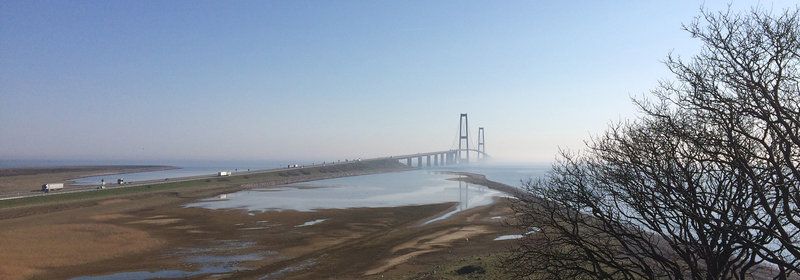Sprogø - The connecting island of Zealand and Funen
In the middle of the Great Belt you can find Sprogø. Sprogø connects the tunnel and high bridge of the Great Belt Bridge. The small island was in connection with the building of the bridge expanded to four times its original size. Sprogø is divided in Old Sprogø and New Sprogø. A conservation plan for the protected nature areas on Old Sprogø has been made to keep the area's mark of marsh in a way, so Old and New Sprogø is naturally connected.
Old and New Sprogø
Sprogø was formed under the latest Ice Age, when the ice's movements pushed moraine deposits up. Typically, moraine deposits are very uneven, which Sprogø is also marked from with many different soil types. When the law regarding the Great Belt connection was about to pass in the parliament, it was not quiet. It was accepted that the nature, which would be ruined on Old Sprogø during the building, should be compensated by the creation of New Sprogø.
Ny Sprogø is therefore reconstructed with 10.000 year old Ice Age deposits, which were brought up from the tunnel digging. A layer of soil from Old Sprogø was also spread over New Sprogø to create the same animal and plant life. This was done to protect as much of the nature life on the island.
The nature on Sprogø
The nature on Sprogø is quite unique, and on the island you can find plants and animals, which are very rare in the rest of Denmark. Sprogø is located in a natura 2000-area. These areas are characterized by housing special nature types or animals, which demands an extra conservation effort. Sund & Bælt has an objective to take as much regard to the nature and animal life on the island.
Sprogø is located in an area with a low annual rainfall and many sunshine hours. This is favoring a range of plants with main bases in Central- and Eastern Europe and Asia. There has been found about 300 different sorts of plants on the island. In addition, about 50 different species of birds are breeding on the island. You can also find sheep and cows, who ensures natural grazing.
The Girl Home
The story about the old girl home on Sprogø is terrible and horrifying. From 1923 to 1961, Sprogø was the home for up to 500 sexually deranged and morally defect women. The asylum was not a prison, but the women - who were seen as sick - lived here indefinitely without possibility of leaving. The women were sent to the island if they, by the local community, were seen as being mentally unstable, or if they simple had a different behavior than the norm.
At the girl home, the chief physician were in charge. He decided, whether the women were to be sent to the island, and if they were allowed to leave again. He decided the activities for the women, the punishments and rewards, they could receive, and other things. At the home, a hostess was also present. She was the example of how women should behave to prove that they were capable of parole. After a change in the sterilization law in 1934, it was almost a condition for women to be sterilized before leaving the island.
The women were on average at the home in seven years. Through the 1950s, fewer and fewer women were placed there, and the female head doctor, who was in charge of the home in 1959, thought the clientele had changed, and the home belonged in the past. The asylum was closed, and the last girl left Sprogø in 1961.
Valdemars castle
One of the most dramatic and changing periods in Denmark's history took place in the middle of the 1100s. Denmark got hereditary monarchy, Valdemar the Great fought the Wends, and wealth and development for the country followed. It was in this time, Danevirke was build, and fortresses were built by Korsør, Nyborg, Vordingborg, Kalundborg - and also on Sprogø.
Today it might seem strange that Valdemar the Great chose to build a fortress on Sprogø - an island with nothing to protect - but at that time, the island had big influence. It was used as a prison, treasury, resting place for travels around the kingdom, and most importantly - as the king's residence, if he were to be attacked. Sprogø had a natural defense with its high slopes, which were hard to break through.
Today, the 24 meters tall lighthouse hill - with lighthouse - can be seen. The lighthouse has a certain historical interest and is protected to this day. In 1868, it was built on the remains of the old fortress. The ruins, which are the oldest dated in Denmark, is today renovated by the National Museum together with Sund & Bælt.
Guided tour on Sprogø
VisitVestsjælland arranges guided trips to Sprogø throughout the year. The tour takes about 3 hours and is not suitable for people with wheelchairs or reduced walking ability.
The tour can be booked at: www.visitvestsjaelland.dk or www.visitnyborg.dk

Gps: 55.333868, 10.969621
Fodsporet - walking and cycling route
Ruds Vedby - The gardens of Birkegården
Skortskærgaard Bed and Breakfast and visitor farm - host article
Rosenborg Castle - the entire Danish treasury
Holmegaard Værk - classic Danish glass art
Faarevadskrog BB - host article
Skibene på Holmen
The world’s largest Viking hall
One of the world’s 100 best experiences
Kaptajnhuset BB - host article
Copenhagen - Dyrehavsbakken and Eremitagen
Kragenæs - Dodekalitten
Korsør - Sprogø
Møns Klint - And Geo Center
Roskilde - The Viking Ship Museum 1
Roskilde - The Viking Ship Museum 2
Roskilde and Lejre - Its Viking country
Northwest Zealand
Zealand - Specialties
Zealand - Holiday Experiences